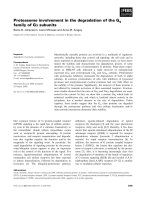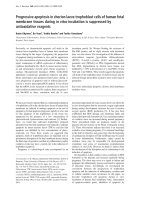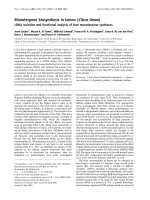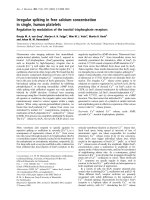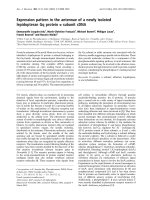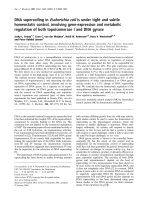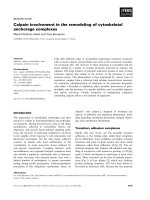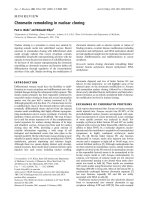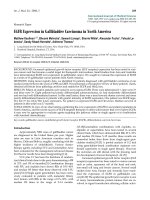Báo cáo y học: "Vascular involvement in rheumatic diseases: ‘vascular rheumatology" pps
Bạn đang xem bản rút gọn của tài liệu. Xem và tải ngay bản đầy đủ của tài liệu tại đây (137.69 KB, 10 trang )
Page 1 of 10
(page number not for citation purposes)
Available online />Abstract
The vasculature plays a crucial role in inflammation, angiogenesis,
and atherosclerosis associated with the pathogenesis of inflam-
matory rheumatic diseases, hence the term ‘vascular rheumatology’.
The endothelium lining the blood vessels becomes activated during
the inflammatory process, resulting in the production of several
mediators, the expression of endothelial adhesion molecules, and
increased vascular permeability (leakage). All of this enables the
extravasation of inflammatory cells into the interstitial matrix. The
endothelial adhesion and transendothelial migration of leukocytes
is a well-regulated sequence of events that involves many adhesion
molecules and chemokines. Primarily selectins, integrins, and
members of the immunoglobulin family of adhesion receptors are
involved in leukocyte ‘tethering’, ‘rolling’, activation, and trans-
migration. There is a perpetuation of angiogenesis, the formation of
new capillaries from pre-existing vessels, as well as that of
vasculogenesis, the generation of new blood vessels in arthritis
and connective tissue diseases. Several soluble and cell-bound
angiogenic mediators produced mainly by monocytes/macro-
phages and endothelial cells stimulate neovascularization. On the
other hand, endogenous angiogenesis inhibitors and exogenously
administered angiostatic compounds may downregulate the
process of capillary formation. Rheumatoid arthritis as well as
systemic lupus erythematosus, scleroderma, the antiphospholipid
syndrome, and systemic vasculitides have been associated with
accelerated atherosclerosis and high cardiovascular risk leading to
increased mortality. Apart from traditional risk factors such as
smoking, obesity, hypertension, dyslipidemia, and diabetes, inflam-
matory risk factors, including C-reactive protein, homocysteine,
folate deficiency, lipoprotein (a), anti-phospholipid antibodies, anti-
bodies to oxidized low-density lipoprotein, and heat shock proteins,
are all involved in atherosclerosis underlying inflammatory rheu-
matic diseases. Targeting of adhesion molecules, chemokines, and
angiogenesis by administering nonspecific immunosuppressive
drugs as well as monoclonal antibodies or small molecular
compounds inhibiting the action of a single mediator may control
inflammation and prevent tissue destruction. Vasoprotective agents
may help to prevent premature atherosclerosis and cardiovascular
disease.
Introduction
Vessels and the vascular endothelium are involved in the
pathogenesis of inflammatory rheumatic diseases. Rheuma-
toid arthritis (RA) serves as a prototype of these diseases as
it is the most common type of arthritis and a great body of
data is available regarding leukocyte recruitment into the
synovium, angiogenesis, and accelerated atherosclerosis.
The term ‘vascular rheumatology’ has been accepted by
many investigators and includes both microvascular and
macrovascular involvement in rheumatic diseases. Apart from
RA, systemic lupus erythematosus (SLE), systemic sclerosis
(SSc), the antiphospholipid syndrome (APS), and systemic
vasculitides have been associated with vascular inflammation,
altered angiogenesis, and increased cardiovascular morbidity
and mortality. In this review, we will discuss the most relevant
Review
Vascular involvement in rheumatic diseases:
‘vascular rheumatology’
Zoltán Szekanecz
1
and Alisa E Koch
2,3
1
University of Debrecen Medical Center, Institute of Medicine, Department of Rheumatology, 22 Móricz street, Debrecen, H-4032, Hungary
2
Veterans’ Administration Ann Arbor Healthcare System, 2215 Fuller Road, Ann Arbor, MI 48105, USA
3
University of Michigan Health System, Division of Rheumatology, Department of Internal Medicine, University of Michigan Medical School,
109 Zina Pitcher Place, Ann Arbor, MI 48109-2200, USA
Corresponding author: Zoltán Szekanecz,
Published: 10 October 2008 Arthritis Research & Therapy 2008, 10:224 (doi:10.1186/ar2515)
This article is online at />© 2008 BioMed Central Ltd
β2GPI = β2 glycoprotein I; AECA = anti-endothelial cell antibody; Ang = angiopoietin; anti-CCP = anti-cyclic citrullinated peptide; anti-oxLDL =
anti-oxidized low-density lipoprotein; APA = antiphospholipid antibody; APS = antiphospholipid syndrome; C = cysteine; CAM = endothelial
adhesion molecule; ccIMT = common carotid intima-media thickness; CRP = C-reactive protein; CTAP-III = connective tissue-activating peptide-III;
CVD = cardiovascular disease; DMARD = disease-modifying antirheumatic drug; EC = endothelial cell; ECM = extracellular matrix; EGF = epider-
mal growth factor; ELR = glutamic acid-leucine-arginine; ENA-78 = epithelial neutrophil-activating protein-78; EPC = endothelial progenitor cell;
FGF = fibroblast growth factor; FMD = flow-mediated vasodilation; groα = growth-regulated oncogene-alpha; HEV = high endothelial venule; HIF =
hypoxia-inducible factor; ICAM = intercellular adhesion molecule; IFN = interferon; IL = interleukin; IP-10 = interferon-gamma-inducible 10-kDa
protein; JAM = junctional adhesion molecule; LDL = low-density lipoprotein; LFA = lymphocyte function-associated antigen; MCP-1 = monocyte
chemoattractant protein-1; Mig = monokine induced by interferon-gamma; MIP-1α = macrophage inflammatory protein-1-alpha; MMP = matrix metal-
loproteinase; MTX = methotrexate; oxLDL = oxidized low-density lipoprotein; PAPS = primary antiphospholipid syndrome; PECAM-1 = platelet-
endothelial cell adhesion molecule-1; PF4 = platelet factor-4; RA = rheumatoid arthritis; SDF-1 = stromal cell-derived factor-1; SLE = systemic
lupus erythematosus; SSc = systemic sclerosis; TGF-β = transforming growth factor-beta; TNF = tumor necrosis factor; VCAM = vascular cell
adhesion molecule; VEGF = vascular endothelial growth factor.
Page 2 of 10
(page number not for citation purposes)
Arthritis Research & Therapy Vol 10 No 5 Szekanecz and Koch
information on arthritis-related vascular inflammation, inclu-
ding the role of endothelial cells (ECs), endothelial adhesion
molecules (CAMs) and chemokines, as well as the involve-
ment of neovascularization and some aspects of accelerated
atherosclerosis in rheumatic diseases. We will discuss RA in
more detail, and other connective tissue diseases described
above will also be mentioned. Finally, some aspects of vascular
targeting in rheumatology will also be briefly summarized.
Endothelial biology and leukocyte trafficking
through the vessel wall
Vascular permeability and vascular damage underlying
inflammation
In arthritis, leukocyte ingress into the synovium occurs by
leukocyte adhesion to ECs and then by transendothelial
migration [1-8]. The chemotaxis of these leukocytes is regu-
lated mainly by various chemokines [1,8,9-14]. Several CAMs
have been implicated in leukocyte-EC interactions [1-4,7,8].
ECs play an active role in inflammation. Synovitis is
associated with vasodilation and increased endothelial per-
meability (leakage) and vascular injury followed by endothelial
regeneration [4-6]. ECs secrete several vasodilatory mediators,
including nitric oxide, prostacyclin (PGI
2
), platelet-activating
factor, histamine, and others [4-6]. Increased vascular
permeability associated with EC retraction and contraction
may be a physiological process, while in inflammation, pro-
inflammatory mediators trigger vascular damage [4-6].
Increased vascular permeability is induced primarily by
vasoactive agents such as histamine, serotonin, bradykinin,
and others [4-6,15]. Vascular injury is caused primarily by
activated neutrophils, inflammatory mediators released by
these cells, including reactive oxygen intermediates and
matrix metalloproteinases (MMPs). Anti-EC antibodies
(AECAs), tumor necrosis factor-alpha (TNF-α), interleukin-1
(IL-1), or interferon-gamma (IFN-γ) stimulates EC injury [4-
6,15]. The abundant production of AECAs, markers of
vascular damage, has been reported in RA, SLE, systemic
vasculitis, and other rheumatic diseases [15] (Table 1). Injury
is followed by endothelial regeneration, which may be
associated with angiogenesis or may occur without the
formation of new blood vessels [5,6,16].
Intercellular adhesion molecules in arthritis
The cascade of leukocyte transendothelial migration begins
with the adhesion of leukocytes, including neutrophils,
lymphocytes, and monocytes, to postcapillary venules.
Leukocyte recruitment occurs through the wall of these
venules. In some RA patients, specialized ECs resembling
high endothelial venules (HEVs) are found in the synovium.
These HEVs are surrounded by lymphoid aggregates
composed of T cells [1,2,8]. Inflammatory leukocyte recruit-
ment into inflamed tissue is very similar to the ‘homing’
associated with physiological immune surveillance [1-3].
Leukocyte adhesion to ECs or to extracellular matrix (ECM)
constituents is mediated by endothelial CAMs and their
counter-receptors on infiltrating white blood cells. Primarily
selectins, integrins, and some members of the immuno-
globulin superfamily of adhesion molecules (CAMs) have
been implicated in leukocyte extravasation, but some other
CAMs may also play a role in this process [2,3,7]. These
CAMs are summarized in Table 2. During leukocyte trans-
endothelial migration, selectins mediate the initial ‘tethering’
and ‘rolling’ of leukocytes whereas integrins and other CAMs
are involved in firm adhesion and migration of leukocytes
[1,3,8]. All selectins, most integrins, and members of the
immunoglobulin superfamily are abundantly expressed in
arthritic synovial tissues [2,3]. Other CAMs involved in leuko-
cyte-EC adhesion underlying inflammation include intra-
cellular adhesion molecule-3 (ICAM-3), the lymphocyte
function-associated antigen-3 (LFA-3)-CD2 counter-receptors,
various alternative forms of CD44, vascular adhesion proteins
(VAP-1 and VAP-2), endoglin (CD105), E-cadherin, N-
cadherin, cadherin-11, platelet-endothelial cell adhesion
molecule-1 (PECAM-1) (CD31), junctional adhesion molecules
(JAMs), CD99, and others [1-3,7]. All of these CAMs have
been detected in arthritic synovial tissues [1-3].
Chemokines and chemokine receptors in synovial
inflammation
Chemokines are small proteins exerting chemotactic activity
toward leukocytes [9-12,14,17,18]. Chemokines have been
classified into supergene families according to the location of
cysteine (C) in their molecular structure. These families are
designated as CXC, CC, C, and CX
3
C chemokines; the
particular chemokine ligand members are CXCL, CCL, CL,
and CX
3
CL, and the four chemokine receptor groups are
CXCR, CCR, CR, and CX
3
CR, respectively [9,10,12]. To
date, more than 50 chemokines and 19 chemokine receptors
have been identified [9,10,12] (Table 3). Most CXC chemo-
kines chemoattract neutrophils, but platelet factor-4 (PF4)/
CXCL4 and IFN-γ-inducible 10-kDa protein (IP-10)/CXCL10
recruit lymphocytes and monocytes [9]. Among CXC
chemokines, IL-8/CXCL8, epithelial neutrophil-activating
Table 1
Some important inflammatory mediators released by vascular
endothelial cells
Cytokines Interleukin-1
Interleukin-6
Chemokines Interleukin-8/CXCL8
Monocyte chemoattractant protein-1/CCL2
Growth-regulated oncogene-alpha/CXCL1
Growth factors Endothelial cell-derived growth factor
Transforming growth factor-beta
Colony-stimulating Granulocyte colony-stimulating factor
factors Granulocyte-macrophage colony-stimulating
factor
Others Platelet-activating factor
Nitric oxide
Prostacyclin (PGI
2
)
Page 3 of 10
(page number not for citation purposes)
protein-78 (ENA-78)/CXCL5, growth-regulated oncogene-
alpha (groα)/CXCL1, connective tissue-activating peptide-III
(CTAP-III)/CXCL7, granulocyte chemotactic protein-2/
CXCL6, IP-10/CXCL10, PF4/CXCL4, monokine induced by
IFN-γ (Mig)/CXCL9, stromal cell-derived factor-1 (SDF-1)/
CXCL12, B cell-activating chemokine-1/CXCL13, and
CXCL16 have been implicated in the pathogenesis of
synovial inflammation [14,17,18]. CC chemokines stimulate
monocyte chemotaxis and some of them also chemoattract
lymphocytes [10]. Monocyte chemoattractant protein-1
(MCP-1)/CCL2, macrophage inflammatory protein-1-alpha
(MIP-1α)/CCL3, MIP-3α/CCL20, RANTES (Regulated upon
Activation, Normal T-cell Expressed and Secreted)/CCL5,
Epstein-Barr virus-induced gene-1 ligand chemokine (ELC)/
CCL19, secondary lymphoid tissue chemokine (SLC)/CCL21,
and chemokine-like factor-1 (CKLF1) have been implicated in
inflammatory mechanisms underlying synovitis [14,17,18].
The C chemokine family contains two members: lympho-
tactin/XCL1 and single C motif-1-beta (SCM-1β)/XCL2 [12].
Lymphotactin/XCL1 has been detected on synovial T cells in
RA [14,18]. The CX
3
C chemokine subfamily contains frac-
talkine/CX
3
CL1 [12,19]. This chemokine chemoattracts
mononuclear cells and also serves as a CAM [17,19].
Fractalkine/CX
3
CL1 has also been detected in RA synovial
tissues [19]. Fractalkine/CX
3
CL1 has also been implicated in
the development of accelerated atherosclerosis [18], a topic
discussed later. Chemokines bind to their seven-
transmembrane domain receptors expressed on the target
cells [12,18]. Some of these receptors have numerous
chemokine ligands whereas others are specific receptors for
single ligands [14]. Chemokine receptors have also been
associated with various histological subtypes of inflammation.
For example, whereas CXCR3 and CCR5 may be involved
primarily in Th1 type diseases (such as RA), CCR3, CCR4,
and CCR8 may play a role in leukocyte migration underlying
Th2 type inflammation (such as asthma) [11]. Most CXC and
CC chemokine receptors mentioned above as well as XCR1
and CX
3
CR1 are expressed in the arthritic synovium
[14,17,18].
The process of leukocyte recruitment into inflamed
tissues
Leukocyte adhesion to ECs occurs following a cascade of
events. White blood cells in the bloodstream weakly adhere
to the endothelium lining the inner vessel wall (tethering)
followed by rolling of leukocytes on the endothelial layer.
Tethering and rolling are mediated primarily by selectins and
their ligands. These events are followed by leukocyte
activation, which is dependent upon interactions between
chemokine receptors expressed on leukocytes and proteo-
glycans on ECs. Activation-dependent firm adhesion occurs
next, involving α
4
β
1
integrin/VCAM-1 (vascular cell adhesion
molecule-1), β
2
integrin/ICAM-1, and JAM/integrin inter-
actions. This is associated with the secretion of chemokines.
These chemokines may also upregulate integrin expression
on the adhering cells via PI3K (phosphatidylinositol 3-kinase)-
Available online />Table 2
Relevant members of the selectin, integrin, and immunoglobulin adhesion molecule superfamilies
Adhesion receptors Ligands
Selectins
L-selectin (CD62L, LAM-1) Sialylated carbohydrates, GlyCAM-1
E-selectin (CD62E, ELAM-1) Sialyl-Lewis-X
P-selectin (CD62P, PADGEM) Sialyl-Lewis-X, other carbohydrates
Integrins
β
1
integrins Laminin, collagen, fibronectin
α
4
β
1
integrins Fibronectin, VCAM-1
β
2
integrins ICAM-1, ICAM-2, ICAM-3, JAM-A
β
3
integrins Vitronectin, von Willebrand factor, other matrix molecules
Immunoglobulin superfamily
ICAM-1, ICAM-3 α
L
β
2
(LFA-1), α
M
β
2
(Mac-1, CR3)
VCAM-1 α
4
β
1
, α
4
β
7
CD2 LFA-3
PECAM-1 (CD31) PECAM-1, α
V
β
3
integrin
ELAM-1, endothelial-leukocyte adhesion molecule-1; GlyCAM-1, glycosylation-dependent cell adhesion molecule-1; ICAM, intracellular adhesion
molecule; JAM-A, junctional adhesion molecule-A; LAM-1, leukocyte adhesion molecule-1; LFA, lymphocyte function-associated antigen; Mac-1,
macrophage integrin; PADGEM, platelet activation-dependent granule-external membrane protein; PECAM-1, platelet-endothelial cell adhesion
molecule-1; VCAM-1, vascular cell adhesion molecule-1.
mediated pathways. Leukocyte diapedesis through the
endothelial layer involving integrins occurs when chemokines
bind to endothelial heparan sulphate. Chemokines preferen-
tially chemoattract EC-adherent leukocytes. These processes
lead to the transmigration of leukocytes into the inflamed
tissue [1,8].
Targeting of cell adhesion, chemokines, and leukocyte
recruitment
Inhibition of cell adhesion, chemokines, and migration using
specific antibodies or purified ligands has provided an
important perspective on the molecular pathogenesis of RA.
In addition, some of these strategies may be included in the
future therapy of arthritis [20]. Regarding anti-CAM trials, an
anti-human ICAM-1 antibody (enlimomab) was tried in
refractory RA with little success [2,20]. Other antiadhesion
strategies have been introduced into the treatment of other
inflammatory diseases. For example, efalizumab (anti-LFA-1)
and alefacept (LFA-3-Ig fusion protein) have been tried in
psoriasis, natalizumab (anti-α
4
integrin) in multiple sclerosis
and Crohn disease, and an anti-α
4
β
7
integrin monoclonal
antibody in ulcerative colitis [2,3,20]. These and other anti-
CAM strategies may be tried in arthritis as well [2,3,20].
Chemokines and chemokine receptors can be targeted in a
number of ways. Disease-modifying antirheumatic drugs
(DMARDs) and anti-TNF biologics, currently used in the
treatment of RA, may indirectly influence chemokine produc-
tion [18]. Antibodies to IL-8/CXCL8, ENA-78/CXCL5,
CXCL16, MIP-1α/CCL3, MCP-1/CCL2, and fractalkine/
CX
3
CL1 have been used to control arthritis in various rodent
models [18-20]. Several oral chemokine receptor antago-
nists, including CXCR2, CXCR4, CCR1, CCR2, and CCR5
inhibitors, have been tried in human RA as well as in animal
models of arthritis [18,20-22].
Angiogenesis and vasculogenesis in
rheumatic diseases
The processes of angiogenesis and vasculogenesis
Angiogenesis is the formation of new capillaries from pre-
existing vessels, whereas vasculogenesis involves circulating
endothelial progenitor cells (EPCs) [14,16,23-27]. Angio-
genesis involves cell surface-bound and soluble angiogenic
mediators, which activate vascular ECs (Table 4). In
response, ECs release MMPs, which digest the underlying
basal membrane and the ECM enabling the emigration of
ECs. Single ECs will then gather to form capillary sprouts.
Lumen formation within the sprouts leads to capillary loops.
Finally, the synthesis of new basement membrane leads to
the formation of new capillaries [23]. Regarding vasculo-
genesis, a subpopulation of circulating CD34
+
cells expres-
sing the vascular endothelial growth factor-2 (VEGF-2)
receptor has been identified and characterized as functional
EPCs. Decreased numbers of EPCs as well as impaired
vasculogenesis have been associated with arthritis [27,28].
Arthritis Research & Therapy Vol 10 No 5 Szekanecz and Koch
Page 4 of 10
(page number not for citation purposes)
Table 3
Chemokine receptors with ligands relevant for arthritis and angiogenesis
Chemokine receptor Chemokine ligand
CXC chemokine receptors
CXCR1 IL-8/CXCL8
CXCR2 IL-8/CXCL8, ENA-78/CXCL5, groα/CXCL1, CTAP-III/CXCL7
CXCR3 IP-10/CXCL10, PF4/CXCL4, Mig/CXCL9, ITAC/CXCL11
CXCR4 SDF-1/CXCL12
C-C chemokine receptors
CCR1 MIP-1α/CCL3, RANTES/CCL5, MCP-3/CCL7, MPIF-1/CCL23
CCR2 MCP-1/CCL2, MCP-3/CCL7
CCR6 MIP-3α/CCL20
CCR7 MIP-3β/CCL19, SLC/CCL21
C chemokine receptors
XCR1 Lymphotactin/XCL1
C-X3-C chemokine receptors
CX
3
CR1 Fractalkine/CX
3
CL1
CTAP-III, connective tissue-activating peptide-III; ENA-78, epithelial neutrophil-activating protein-78; groα, growth-regulated oncogene-alpha; IL-8,
interleukin-8; IP-10, interferon-gamma-inducible 10-kDa protein; ITAC, interferon-inducible T-cell alpha chemoattractant; MCP, monocyte
chemoattractant protein; Mig, monokine induced by interferon-gamma; MIP, macrophage inflammatory protein; MPIF-1, myeloid progenitor
inhibitory factor-1; PF4, platelet factor-4; RANTES, Regulated upon Activation, Normal T-cell Expressed and Secreted; SDF-1, stromal cell-derived
factor-1; SLC, secondary lymphoid tissue chemokine.
The major chemoattractant that drives EPCs is the SDF-
1/CXCL12 chemokine and its receptor, CXCR4 [29]. In
arthritis, proinflammatory cytokines stimulate the production
of SDF-1/CXCL12 and thus tissue vasculogenesis by
recruiting CXCR4
+
EPCs [14,17,29].
Angiogenic mediators and inhibitors in rheumatoid
arthritis
The hypoxia-VEGF-angiopoietin pathway is an essential
angiogenic network in synovitis [16,23-25,30]. VEGF, a
growth factor that binds to heparin in the synovial ECM, plays
a central role in the regulation of neovascularization [23,30].
There is hypoxia present within the joint cavity, and hypoxia as
well as TNF-α and IL-1 stimulate VEGF release [16]. Hypoxia
acts through the hypoxia-inducible factor heterodimer, HIF-1α/
HIF-1β [16]. Several other angiogenic mediators also act
indirectly via VEGF [23]. Angiopoietin-1 (Ang1) and Ang2
regulate EC functions upon stimulation by VEGF. Both Ang1
and Ang2 interact with the Tie2 endothelial tyrosine kinase
receptor [16,24]. Ang1-Tie2 interactions result in vessel
stabilization. On the other hand, Ang2, an antagonist of Ang1,
inhibits vessel maturation [24]. Another important player in
this network is survivin, an apoptosis inhibitor, which is also
involved in VEGF-induced angiogenesis and EC survival [16].
VEGF, HIF-1, Ang1, Tie2, and survivin are all expressed in the
arthritic synovium [16,25]. Growth factors other than VEGF
but implicated in angiogenesis include fibroblast (FGF-1 and
FGF-2), hepatocyte, platelet-derived, epidermal (EGF), insulin-
like, and transforming (TGF-β) growth factors [16,24,25].
Among chemokines described above, CXC chemokines that
contain the ELR (glutamic acid-leucine-arginine) amino acid
motif promote angiogenesis [13]. ELR
+
CXC chemokines
that stimulate angiogenesis and also synovial inflammation
include IL-8/CXCL8, ENA-78/CXCL5, groα/CXCL1, and
CTAP-III/CXCL7. SDF-1/CXCL12 is a unique CXC chemo-
kine as it exerts mainly a homeostatic function, yet it has been
implicated in inflammation such as in RA [13,14,17,29].
Moreover, this chemokine lacks the ELR motif but is still
angiogenic [14,29]. The crucial role of SDF-1/CXCL12 in
vasculogenesis is discussed above [29]. In contrast to
angiogenic CXC chemokines, the ELR
–
PF4/CXCL4, IP-10/
CXCL10, and Mig/CXCL9 suppress neovascularization
[13,14,17]. Regarding CC chemokines, MCP-1/CCL2
promotes neovascularization induced by growth factors
[14,17]. The sole CX
3
C chemokine, fractalkine/CX
3
CL1, also
promotes synovial angiogenesis [14,17,19]. Regarding
chemokine receptors, CXCR2, which binds most ELR
+
CXC
chemokines described above, is a crucial chemokine
receptor in angiogenesis [13,14,17]. CXCR4 has been
implicated in SDF-1/CXCL12-induced neovascularization in
arthritis [14,17,29]. In contrast, CXCR3, a receptor for the
angiostatic IP-10/CXCL10 and Mig/CXCL9, may be involved
in chemokine-mediated angiostasis [14,17]. Numerous
proinflammatory cytokines, such as TNF-α, IL-1, IL-6, IL-15,
IL-17, IL-18, granulocyte and granulocyte-macrophage
colony-stimulating factors, oncostatin M, and macrophage
migration inhibitory factor, also induce synovial angiogenesis
[16,31]. In contrast, other cytokines, such as IFN-α, IFN-γ,
IL-4, IL-12, IL-13, and leukemia inhibitory factor, suppress the
production of angiogenic mediators and thus inhibit neo-
vascularization [16,31,32]. ECM components, matrix-degra-
ding proteases, and cellular adhesion molecules described
above may be involved in EC emigration, sprouting, and thus
angiogenesis. Among ECM components, various types of
collagen, fibronectin, laminin, vitronectin, tenascin, and
proteoglycans promote neovascularization [16]. Proteolytic
enzymes, such as MMPs and plasminogen activators, play a
role in matrix degradation underlying synovial angiogenesis
[16,25]. On the other hand, tissue inhibitors of metallo-
proteinases and plasminogen activator inhibitors antagonize
the angiogenic effects of proteases described above [16,32].
Among CAMs, β
1
and β
3
integrins, E-selectin, glycoconju-
gates (including Lewis
y
/H), melanoma cell adhesion molecule
(MUC18), VCAM-1, PECAM-1, and endoglin have been
implicated in neovascularization [2,16,25,33,34]. The α
V
β
3
integrin is of outstanding importance as this CAM mediates
both synovial angiogenesis and osteoclast-mediated bone
resorption and the development of erosions in RA [34]. Other
important angiogenic factors not mentioned above include
endothelin-1, angiogenin, angiotropin, and many others
[16,25] (Table 4). Angiostatic mediators and compounds also
include angiostatin (a fragment of plasminogen), endostatin
(a fragment of type XIII collagen), thrombospondin-1,
2-methoxyestradiol, paclitaxel, osteonectin, chondromodulin-1,
and others [16,30,32,35] (Table 4). These molecules
suppress the action of angiogenic mediators, such as VEGF,
HIFs, or the α
V
β
3
integrin [16,30,32,35].
Angiogenesis in other types of arthritis and connective
tissue diseases
Differential vascular morphology may exist in the synovia of
RA versus psoriatic arthritis (PsA) patients [16,25]. Further-
more, VEGF production may be associated with increased
disease activity and accelerated angiogenesis in PsA and
ankylosing spondylitis [16]. In SLE, angiogenic EGF, FGF,
and IL-18 as well as angiostatic endostatin have been
detected in the sera of patients. Serum VEGF levels were
correlated with the SLAM (systemic lupus activity measure)
activity score [16,25]. Angiogenesis in SSc is somewhat
controversial. On one hand, there is significant loss of vessels
in scleroderma despite severe tissue hypoxia associated with
increased concentrations of the angiostatic endostatin
[16,28]. On the other hand, SSc skin biopsy explants stimu-
lated neovascularization and there is increased production of
VEGF in the sera and skin of scleroderma patients [16,28].
Thus, hypoxia may induce angiogenesis in SSc but this is
transient and the newly formed vessels are rather unstable in
this disease [28]. Furthermore, sustained production of VEGF
results in the formation of giant capillaries seen using capil-
laroscopy in SSc [16,28]. Similarly to SSc, in inflammatory
myopathies, expression of hypoxia-associated increased
HIF-1, α
V
β
3
integrin, and VEGF receptor in muscle biopsies
Available online />Page 5 of 10
(page number not for citation purposes)
was not sufficient to compensate the loss of blood vessels
[16,25]. Regarding systemic vasculitides, abundant produc-
tion of angiogenic VEGF and TGF-β has been associated
with Kawasaki syndrome [16]. Increased serum levels of
TGF-β were found in ANCA (antineutrophil cytoplasmic
antibody)-associated vaculitides, including Wegener
granulomatosis, Churg-Strauss syndrome, and microscopic
polyangiitis [16,25].
Targeting of angiogenesis in inflammatory rheumatic
diseases
There may be two major strategies to control angiogenesis in
arthritis as well as in malignancies [16,32,35]. Endogenous
inhibitors of neovascularization described above, including
cytokines, chemokines, protease inhibitors, and others, are
naturally produced in the arthritic synovium. However, angio-
genic mediators are abundant within the inflamed tissue;
therefore, these endogenous angiostatic molecules need to
be administered in excess in order to attenuate neo-
vascularization. In addition, numerous synthetic compounds
currently used to control inflammation and to treat arthritis
may, among other effects, inhibit capillary formation as well.
These exogenous angiostatic compounds include cortico-
steroids, traditional disease-modifying agents (DMARDs) and
biologics, antibiotic derivatives, thalidomide, and others
[16,32,35] (Table 5). Among endogenous angiogenesis
inhibitors, angiostatin and endostatin block α
V
β
3
integrin-
dependent angiogenesis and both molecules inhibited the
development of arthritis in various animal models [16,35].
Thrombospondin-1 and -2 are angiostatic ECM components
produced by RA synovial macrophages and fibroblasts
[16,32]. IL-4 and IL-13 gene transfer attenuated synovial
inflammation and angiogenesis in rats [16]. The PF4/CXCL4
chemokine has also been tried in rodent models [16].
Fumagillin analogs, such as TNP-470 and PPI2458, also
exert angiostatic and antiarthritic properties [16,32,35].
Traditional DMARDs and biologics exert various anti-
inflammatory effects. In addition, these compounds may
inhibit synovial vessel formation by nonspecifically blocking
the action of angiogenic mediators [16,17]. Thalidomide,
recently introduced into the treatment of RA and lupus, is a
potent TNF-α antagonist and angiogenesis inhibitor [16,35].
CC1069, a thalidomide analog, even more potently inhibited
arthritis in rats [35]. The hypoxia-HIF pathway may also be
targeted using nonspecific inhibitor compounds, including
YC-1 [16,35]. 2-Methoxyestradiol, mentioned above, and
paclitaxel (taxol), a drug already used in human cancer,
destabilize the intracellular cytoskeleton and also block HIF-
1α [35]. Soluble Fas ligand (CD178) inhibited synovial VEGF
production and angiogenesis [16]. Pioglitazone, an anti-
diabetic PPAR-γ (peroxisome proliferator-activated receptor-
gamma) agonist, is also angiostatic. Pioglitazone effectively
controlled psoriatic arthritis in 10 patients [16,35]. Regarding
specific exogenous strategies, VEGF is the key target
[30,35]. Numerous synthetic VEGF and VEGF receptor
inhibitors (including vatalanib, sunitinib, sorafenib, and
vandetanib), anti-VEGF antibodies (including bevacizumab),
and inhibitors of VEGF and VEGF receptor signaling inhibit
neovascularization and are under development for cancer
therapy [30,35]. To date, vatalanib has been tried and
Arthritis Research & Therapy Vol 10 No 5 Szekanecz and Koch
Page 6 of 10
(page number not for citation purposes)
Table 4
Some angiogenic and angiostatic factors in arthritis
Mediators Inhibitors
Chemokines IL-8/CXCL8, ENA-78/CXCL5, groα/CXCL1, CTAP-III/CXCL7, PF4/CXCL4, IP-10/CXCL10, Mig/CXCL9,
SDF-1/CXCL12, MCP-1/CCL2, SLC/CCL21, MPIF/CCL23, SLC/CCL21
fractalkine/CX
3
CL1
Matrix molecules Type I collagen, fibronectin, laminin, heparin, heparan sulphate Thrombospondin, RGD sequence
Cell adhesion molecules β
1
and β
3
integrins, E-selectin, P-selectin, CD34, VCAM-1, RGD sequence (integrin ligand)
endoglin, PECAM-1, vascular endothelial-cadherin,
Lewis
y
/H, MUC18
Growth factors VEGF, bFGF, aFGF, PDGF, EGF, IGF-I, HIF-1, TGF-β
a
TGF-β
a
Cytokines TNF-α, IL-6
a
, IL-15, IL-18 IL-4, IL-6
a
, IFN-α, IFN-γ
Proteases MMPs, plasminogen activators TIMPs, plasminogen activator inhibitors
Others Angiogenin, substance P, prolactin DMARDs, infliximab, etanercept, angiostatin,
endostatin
a
Mediators with both proangiogenic and antiangiogenic effects. aFGF, acidic fibroblast growth factor; bFGF, basic fibroblast growth factor; CTAP-
III, connective tissue-activating peptide-III; DMARD, disease-modifying antirheumatic drug; EGF, epidermal growth factor; ENA-78, epithelial
neutrophil-activating protein-78; groα, growth-regulated oncogene-alpha; HIF-1, hypoxia-inducible factor-1; IFN, interferon; IGF-I, insulin-like growth
factor-I; IL, interleukin; IP-10, interferon-gamma-inducible 10-kDa protein; MCP-1, monocyte chemoattractant protein-1; Mig, monokine induced by
interferon-gamma; MMP, matrix metalloproteinase; MPIF, myeloid progenitor inhibitory factor; MUC18, melanoma cell adhesion molecule; PDGF,
platelet-derived growth factor; PECAM-1, platelet-endothelial cell adhesion molecule-1; PF4, platelet factor-4; RGD, arginine-glycine-aspartic acid;
SDF-1, stromal cell-derived factor-1; SLC, secondary lymphoid tissue chemokine; TGF-β, transforming growth factor-beta; TIMP, tissue inhibitors of
metalloproteinase; TNF-α, tumor necrosis factor-alpha; VCAM-1, vascular cell adhesion molecule-1; VEGF, vascular endothelial growth factor.
attenuated knee arthritis in rabbits [35]. The Ang-Tie system
may also be targeted. A soluble Tie2 receptor transcript was
delivered via an adenoviral vector to mice. The inhibition of
Tie2 delayed the onset and attenuated the severity of arthritis
[16,35]. Vitaxin, a humanized antibody to the α
V
β
3
integrin,
inhibited synovial angiogenesis [16,34] but, in a phase II
human RA trial, showed only limited efficacy [35]. Numerous
specific MMP inhibitors have been tried in angiogenesis
models [16,35]. Endothelin-1 antagonists currently used in
the therapy of primary and SSc-associated secondary
pulmonary hypertension may also exert angiostatic effects
[16,28].
Accelerated atherosclerosis in rheumatic
diseases
The basis of atherosclerosis and increased vascular risk
Accelerated atherosclerosis and increased cardiovascular
morbidity and mortality have been associated with RA, SLE,
APS, and SSc [36-41]. Cardiovascular disease (CVD)
causes reduced life expectancy and became a major mortality
factor in these diseases [36-41]. Atherosclerosis is also
considered an inflammatory disease; thus, it may share
common pathogenic mechanisms with rheumatic diseases
[36,42,43] (Table 6). Numerous studies have demonstrated
the role of traditional, Framingham, and inflammation-asso-
ciated risk factors in atherosclerosis associated with arthritis
[36-38,44]. Among traditional risk factors, cigarette smoking
not only is a major risk factor for CVD but has recently been
implicated in tissue citrullination, the production of anti-cyclic
citrullinated peptide (anti-CCP) antibodies, and thus
susceptibility to RA [36,38]. In addition to smoking, physical
inactivity, obesity, hypertension, dyslipidemia, and diabetes
mellitus may be implicated in accelerated atherosclerosis
[36-38,44]. Yet excess CVD mortality occurs predominantly
in RA patients with a higher degree of systemic inflammation
[36]; therefore, accelerated atherosclerosis cannot be fully
explained on the basis of traditional risk factors [42,43].
Indeed, several inflammatory and atherogenic mediators,
including homocysteine, lipoprotein (a), C-reactive protein
(CRP), hyperhomocysteinemia, and folate, and vitamin B
12
deficiency and decreased paraoxonase-1 activity are strongly
associated with atherosclerosis and CVD [36,42,43]. Athero-
sclerotic plaques, similarly to the RA joint, are characterized
by enhanced accumulation of inflammatory monocytes/
macrophages and T cells. These inflammatory leukocytes
abundantly produce proinflammatory cytokines, chemokines,
and MMPs [42,43]. CD4
+
T cells, especially the CD4
+
/
CD28
–
T-cell subset, have been associated with both arthritis
and inflammation-related vascular damage [37,38,43].
Regarding proinflammatory cytokines, TNF-α and IL-6 play an
important role in atherosclerosis as well as in RA [31,36,43].
Increased production of TNF-α and IL-6 has been associated
with heart failure as well as with insulin resistance, dys-
lipidemia, and obesity [36,43]. In contrast, IL-4 and IL-10 may
exert an anti-inflammatory role during the development of
atherosclerosis by driving Th2 responses [31,43] (Table 6).
Vascular involvement in various rheumatic diseases
In RA, age, gender, ethnicity, traditional risk factors described
above as well as (among RA-related risk factors) disease
duration, activity, and severity, functional impairment, rheuma-
toid factor and anti-CCP status, CRP, radiographic indica-
tors, presence of the shared epitope, and treatment
modalities have been implicated in the development of
accelerated atherosclerosis [36-38,44]. We have recently
assessed common carotid intima-media thickness (ccIMT)
indicating atherosclerosis and flow-mediated vasodilation
(FMD), a marker of endothelial dysfunction in RA. Increased
ccIMT and impaired FMD have been associated with age,
disease duration, and anti-CCP, CRP, and IL-6 production
[44]. In SLE, primary APS (PAPS) and secondary APS
associated with SLE, traditional, and autoimmune-inflam-
matory factors are involved [40]. Among these factors, longer
disease duration and cumulative corticosteroid dose seem to
Available online />Page 7 of 10
(page number not for citation purposes)
Table 5
Antiangiogenic targets
Endogenous inhibitors Angiostatin
Endostatin
Thrombospondin-2
Interleukin-4, interleukin-13
Platelet factor-4/CXCL4 chemokine
Exogenous inhibitors Classical disease-modifying antirheumatic drugs
Anti-tumor necrosis factor biologics
Thalidomide
Fumagillin analogs
Vascular endothelial growth factor inhibitors
Hypoxia-inducible factor heterodimer inhibitors
Angiopoietin-1/Tie2 inhibitors
α
V
β
3
integrin inhibitors
Microtubule destabilizers (for example, paclitaxel)
Others (for example, glitazones)
be the major predictors of clinical atherosclerosis
[37,38,40,41]. Additional inflammatory risk factors include
CRP, fibrinogen, IL-6, costimulatory molecules (CD40/CD40L),
CAMs, anti-phospholipid antibodies (APAs), including anti-
cardiolipin and anti-β2 glycoprotein I (anti-β2GPI), anti-
oxidized low-density lipoprotein (anti-oxLDL), anti-oxidized
palmitoyl arachidonoyl phosphocholine (anti-oxPAPC), anti-
HDL and anti-hsp antibodies, homocysteine, and lipoprotein
(a) [37,40,41]. APAs are of importance in both SLE and APS.
APAs may bind to neoepitopes of oxLDL as well as to oxLDL-
β2GPI complexes, and both APA and anti-oxLDL antibodies
have been implicated in the pathogenesis of atherosclerosis
associated with SLE and APS [37,38,40,41]. Autoantibodies
against oxLDL-β2GPI complexes have been detected in SLE
and PAPS patients [40,41]. Both APA and anti-oxLDL may
account for increased mortality in CVD [41]. The β2GPI
phospholipid cofactor has been detected in the wall of large
arteries in the vicinity of CD4
+
T-cell infiltrates. Macrophages
and ECs bind to β2GPI during the atherosclerotic process
[37,38,41]. Atherosclerosis is the most pronounced in lupus-
associated secondary APS, in which traditional and
nontraditional risk factors are multiplied and atherosclerosis
occurs more prematurely [40,41]. SSc is associated with
both macrovascular disease (including CVD, pulmonary
hypertension, and peripheral arterial occlusion) and micro-
vascular disease (including Raynaud phenomenon) [37-39,
45,46]. Pathogenic factors involved in SSc-associated
vascular damage include increased LDL, homocysteine, and
CRP production [37,39,46]. We recently described the
association of 5,10-methylene-tetrahydrofolate reductase
(MTHFR) C677T polymorphism with homocysteine, vitamin
B
12
production, and macrovascular abnormalities in SSc
[46]. Increased arterial stiffness and ccIMT as well as
impaired FMD have been detected by us [39,45] and others
[37] in scleroderma.
Therapeutic considerations
Anti-inflammatory treatment used in inflammatory rheumatic
diseases may be either proatherogenic or antiatherogenic
[37,47]. Corticosteroids are atherogenic by augmenting dys-
lipidemia, hypertension, and diabetes mellitus [36,47]. In
autopsy studies, long exposure to corticosteroid therapy was
associated with the development of atherosclerosis.
However, other clinical studies could not confirm this
association [36,47]. Glucocorticoids may exert a bimodal
action as they are atherogenic but, on the other hand, also
anti-inflammatory. There is evidence that the above-described
inflammatory factors associated with more active disease may
exert higher risk for atherosclerosis than anti-inflammatory
treatment [37,47]. In contrast to corticosteroids, antimalarial
drugs such as chloroquine and hydroxychloroquine may exert
evident antiatherogenic properties. Antimalarials may reduce
LDL cholesterol, very LDL cholesterol, and (in corticosteroid-
treated patients) triglyceride production [36,37,47].
Methotrexate (MTX) exerts bipolar effects on atherosclerosis
in RA: on one hand, MTX treatment increases plasma levels
of homocysteine, but, on the other hand, MTX controls
several other mediators of inflammation and thus may
beneficially influence the net outcome of CVD in RA [36,47].
Concomitant folate supplementation prevented the increase
of homocysteine production and reduced CVD mortality in
MTX-treated patients [36]. Among biologic agents, TNF-α
Arthritis Research & Therapy Vol 10 No 5 Szekanecz and Koch
Page 8 of 10
(page number not for citation purposes)
Table 6
Common risk factors in the pathogenesis of atherosclerosis underlying rheumatic diseases
1. Traditional Age
Smoking
Dyslipidemia
Hypertension
Diabetes mellitus
Immobilization
Sedentary lifestyle
2. Inflammatory Acute-phase proteins (C-reactive protein, fibrinogen)
Lipoprotein (a)
Folate and vitamin B
12
deficiency
Decreased paraoxonase activity
CD4
+
/CD28
–
T cells
Autoantibodies (anti-CCP, rheumatoid factor, anti-oxLDL, anti-phospholipid antibody, anti-hsp)
Proatherogenic cytokines (tumor necrosis factor-alpha, interleukin-6)
Chemokines
Angiogenic growth factors
Matrix-degrading metalloproteinases
Increased cell adhesion molecule expression
Hyperhomocysteinemia
Defective apoptosis
3. Iatrogenic Methotrexate - bimodal?
Corticosteroids - bimodal?
anti-CCP, anti-cyclic citrullinated peptide; anti-oxLDL, anti-oxidized low-density lipoprotein.
blockers may have significant effects on the vasculature [48].
In RA, infliximab treatment reduced endothelial dysfunction
and ccIMT [48]. We recently proposed that rituximab may
also exert favorable effects on FMD, ccIMT, and dyslipidemia
[49]. Atherosclerosis treatment strategies in rheumatic
diseases should include an aggressive control of all
traditional risk factors, including hyperlipidemia, hypertension,
smoking, obesity, and diabetes mellitus. Both
pharmacological treatment and changes in lifestyle should be
introduced in these patients [47]. There is very little solid
evidence from randomized controlled trials indicating the
preventative action of any drugs in arthritis-associated CVD
[47]. Drug therapy may include the use of antiplatelet agents,
statins, folic acid, B vitamins, and (as described above)
possibly antimalarials [36,47]. A recommendation from the
European League Against Rheumatism for the prevention and
management of CVD in arthritis is about to be published [50].
Summary
In this review, we discussed the putative role of leukocyte-EC
adhesion, chemokines, and angiogenesis in leukocyte recruit-
ment underlying the pathogenesis of inflammatory synovitis. A
number of CAMs are involved in this process. These CAMs
interact with soluble inflammatory mediators such as
cytokines and chemokines. The presence of various CAM
pairs and the existence of distinct steps of rolling, activation,
adhesion, and migration account for the diversity and
specificity of leukocyte-EC interactions. Chemokines and
their receptors drive inflammatory leukocytes into the
synovium. A number of soluble and cell-bound factors may
stimulate or inhibit angiogenesis. The outcome of inflam-
matory and other ‘angiogenic diseases’ such as various forms
of arthritis depends on the imbalance between angiogenic
and angiostatic mediators. There have been several attempts
to therapeutically interfere with the cellular and molecular
mechanisms described above. Specific targeting of leukocyte
adhesion, CAMs, chemokines, chemokine receptors, and/or
angiogenesis, primarily by using agents with multiple actions,
may be useful for the future management of inflammatory
rheumatic diseases.
Competing interests
The authors declare that they have no competing interests.
Acknowledgments
This work was supported by National Institutes of Health (Bethesda,
MD, USA) grants AR-048267 and AI-40987 (AEK), the William D
Robinson, MD, and Frederick GL Huetwell Endowed Professorship
(AEK), funds from the Veterans’ Administration (AEK), and grant
T048541 from the National Scientific Research Fund (OTKA) (ZS).
References
1. Imhof BA, Aurrand-Lions M: Adhesion mechanisms regulating
the migration of monocytes. Nat Rev Immunol 2004, 4:432-
444.
2. Szekanecz Z, Szegedi G, Koch AE: Cellular adhesion mole-
cules in rheumatoid arthritis. Regulation by cytokines and
possible clinical importance. J Investig Med 1996, 44:124-135.
3. Agarwal SK, Brenner MB: Role of adhesion molecules in syn-
ovial inflammation. Curr Opin Rheumatol 2006, 18:268-276.
4. Szekanecz Z, Koch AE: Endothelial cells in inflammation and
angiogenesis. Curr Drug Targ 2005, 4:319-323.
5. Szekanecz Z, Koch AE: Vascular endothelium and immune
responses: implications for inflammation and angiogenesis.
Rheum Dis Clin N Am 2004, 30:97-114.
6. Cotran RS, Pober JS: Cytokine-endothelial interactions in
inflammation, immunity and vascular injury. J Am Soc Nephrol
1990, 1:225-235.
7. Springer TA: Adhesion receptors of the immune system.
Nature 1990, 346:425-433.
8. Butcher EC: Leukocyte-endothelial cell recognition: three (or
more) steps to specificity and diversity. Cell 1991, 67:
1033-1036.
9. Walz A, Kunkel SL, Strieter RM: C-X-C chemokines – an
overview. In Chemokines in Disease. Edited by Koch AE, Strieter
RM. Austin, TX: RG Landes Company; 1996:1-25.
10. Taub DD: C-C chemokines – an overview. In Chemokines in
Disease. Edited by Koch AE, Strieter RM. Austin, TX: RG Landes
Company; 1996:27-54.
11. Moser B, Loetscher P: Lymphocyte traffic control by chemo-
kines. Nat Immunol 2001, 2:123-128.
12. Zlotnik A, Yoshie O: Chemokines: a new classification system
and their role in immunity. Immunity 2000, 12:121-127.
13. Strieter RM, Polverini PJ, Kunkel SL, Arenberg DA, Burdick MD,
Kasper J, Dzuiba J, Van Damme J, Walz A, Marriott D, Chan S-Y,
Roczniak S, Shanafelt AB: The functional role of the ELR motif
in CXC chemokine-mediated angiogenesis. J Biol Chem 1995,
270:27348-27357.
14. Szekanecz Z, Gáspár L, Koch AE: Angiogenesis in rheumatoid
arthritis. Front Biosci 2005, 10:1739-1753.
15. Westphal JR, Boerbooms AMT, Schalkwijk CJM Kwast H, De
Weijert M, Jacobs C, Vierwinden G, Ruiter DJ, Van de Putte LB,
De Waal RM: Anti-endothelial cell antibodies in sera of patients
with autoimmune diseases: comparison between ELISA and
FACS analysis. Clin Exp Immunol 1994, 96:444-449.
16. Szekanecz Z, Koch AE: Mechanism of disease: angiogenesis in
inflammatory diseases. Nat Clin Pract Rheumatol 2007, 3:635-
643.
17. Szekanecz Z, Koch AE: Chemokines and angiogenesis. Curr
Opin Rheumatol 2001, 13:202-208.
18. Szekanecz Z, Szücs G, Szántó S, Koch AE: Chemokines in
rheumatic diseases. Curr Drug Targ 2006, 7:91-102.
19. Ruth JH, Volin MV, Haines III GK, Koch AE: Fractalkine, a novel
chemokine in rheumatoid arthritis and rat adjuvant-induced
arthritis. Arthritis Rheum 2001, 44:1568-1581.
20. Szekanecz Z, Koch AE: Therapeutic inhibition of leukocyte
recruitment in inflammatory diseases. Curr Opin Pharmacol
2004, 4:423-428.
21. Pease JR, Horuk R: CCR1 antagonists in clinical development.
Expert Opin Investig Drugs 2005, 14:785-796.
22. Haringman JJ, Kraan MC, Smeets TJM, Zwinderman KH, Tak PP:
Chemokine blockade and chronic inflammatory disease:
proof of concept in patients with rheumatoid arthritis. Ann
Rheum Dis 2003, 62:715-721.
23. Folkman J, Klagsbrun M: Angiogenic factors. Science 1987, 235:
442-448.
Available online />Page 9 of 10
(page number not for citation purposes)
This article is part of a special collection of reviews, The
Scientific Basis of Rheumatology: A Decade of
Progress, published to mark Arthritis Research &
Therapy’s 10th anniversary.
Other articles in this series can be found at:
/>The Scientific Basis
of Rheumatology:
A Decade of Progress
24. Shahrara S, Volin MV, Connors MA, Haines GK, Koch AE: Differ-
ential expression of the angiogenic Tie receptor family in
arthritic and normal synovial tissue. Arthritis Res 2002, 4:201-
208.
25. Bodolay E, Koch AE, Kim J, Szegedi G, Szekanecz Z: Angiogene-
sis and chemokines in rheumatoid arthritis and other sys-
temic inflammatory rheumatic diseases. J Cell Mol Med 2002,
6:357-376.
26. Peichev M, Naiyer AJ, Pereira D, Zhu Z, Lane WJ, William M, Oz
MC, Hicklin DJ, Witte L, Moore MA, Rafii S: Expression of
VEGFR-2 and AC133 by circulating human CD34(+) cells
identifies a population of functional endothelial precursors.
Blood 2000, 95:952-958.
27. Grisar J, Aletaha D, Steiner CW, Kapral T, Steiner S, Seidinger D,
Weigel G, Schwarzinger I, Wolozcszuk W, Steiner G, Smolen JS:
Depletion of endothelial progenitor cells in the peripheral
blood of patients with rheumatoid arthritis. Circulation 2005,
111:204-211.
28. Koch AE, Distler O: Vasculopathy and disordered angiogene-
sis in selected rheumatic diseases: rheumatoid arthritis and
systemic sclerosis. Arthritis Res Ther 2007, 9 Suppl 2:S3.
29. Petit I, Jin D, Rafii S: The SDF-1-CXCR4 signaling pathway: a
molecular hub modulating neo-angiogenesis. Trends Immunol
2007, 28:299-307.
30. Shibuya M: VEGF-receptor inhibitors for anti-angiogenesis.
Nippon Yakurigaku Zasshi 2003, 122:498-503.
31. Brennan F, Beech J: Update on cytokines in rheumatoid arthri-
tis. Curr Opin Rheumatol 2007, 19:296-301.
32. Auerbach W, Auerbach R: Angiogenesis inhibition: a review.
Pharmacotherapy 1994, 63:265-311.
33. Koch AE, Halloran MM, Haskell CJ, Shah MR, Polverini PJ: Angio-
genesis mediated by soluble forms of E-selectin and vascular
cell adhesion molecule-1. Nature 1995, 376:517-519.
34. Brooks PC, Clark RA, Cheresh DA: Requirement of vascular
integrin alpha v beta 3 for angiogenesis. Science 1994, 264:
569-571.
35. Lainer-Carr D, Brahn E: Angiogenesis inhibition as a therapeu-
tic approach for inflammatory synovitis. Nat Clin Pract
Rheumatol 2007, 3:434-442.
36. Szekanecz Z, Kerekes G, Dér H, Sándor Z, Szabó Z, Végvári A,
Simkovics E, Soós L, Szentpétery Á, Besenyei T, Szücs G, Szántó
S, Tamási L, Szegedi G, Shoenfeld Y, Soltész P: Accelerated
atherosclerosis in rheumatoid arthritis. Ann NY Acad Sci
2007, 1108:349-358.
37. Shoenfeld Y, Gerli R, Doria A, Matsuura E, Cerinic MM, Ronda N,
Jara LJ, Abu-Shakra M, Meroni PL, Sherer Y: Accelerated athero-
sclerosis in autoimmune rheumatic diseases. Circulation
2005, 112:3337-3347.
38. Sherer Y, Shoenfeld Y: Mechanisms of disease: atherosclero-
sis in autoimmune diseases. Nat Clin Pract Rheumatol 2006, 2:
1-8.
39. Szücs G, Timár O, Szekanecz Z, Dér H, Kerekes G, Szamosi S,
Shoenfeld Y, Szegedi G, Soltész P: Endothelial dysfunction pre-
cedes atherosclerosis in systemic sclerosis: relevance for
prevention of vascular complications. Rheumatology (Oxford)
2007, 46:759-762.
40. Szekanecz Z, Shoenfeld Y: Lupus and cardiovascular disease:
the facts. Lupus 2006, 15 Suppl:3-10.
41. Soltész P, Szekanecz Z, Kiss E, Shoenfeld Y: Cardiac manifesta-
tions in antiphospholipid syndrome. Autoimmun Rev 2007, 6:
379-386.
42. Ross R: Atherosclerosis - an inflammatory disease. N Engl J
Med 1999, 340:115-126.
43. Hansson GK: Immune mechanisms in atherosclerosis. Arte-
rioscl Thromb Vasc Biol 2001, 21:1876-1890.
44. Kerekes G, Szekanecz Z, Dér H, Sándor Z, Lakos G, Muszbek L,
Csipo I, Sipka S, Seres I, Paragh G, Kappelmayer J, Szomják E,
Veres K, Szegedi G, Shoenfeld Y, Soltész P: Endothelial dys-
function and atherosclerosis in rheumatoid arthritis: a multi-
parametric analysis using imaging techniques and laboratory
markers of inflammation and autoimmunity. J Rheumatol
2008, 35:398-406.
45. Timár O, Soltész P, Szamosi S, Dér H, Szántó S, Szekanecz Z,
Szücs G: Increased arterial stiffness as the marker of vascular
involvement in systemic sclerosis. J Rheumatol 2008, 35:
1329-1333.
46. Szücs G, Csiki Z, Szomják E, Szolnoki E, Szoke G, Szamosi S,
Szekanecz Z, Szegedi G: Plasma homocysteine levels and the
prevalence of methylenetetrahydrofolate reductase gene
C677T polymorphism in systemic sclerosis [abstract]. Arthritis
Rheum 2003, 48 Suppl:S160.
47. Giles JT, Post W, Blumenthal RS, Bathon JM: Therapy insight:
managing cardiovascular risk in patients with rheumatoid
arthritis. Nat Clin Pract Rheumatol 2006, 2:320-329.
48. Del Porto F, Laganà B, Lai S, Nofroni I, Tinti F, Vitale M, Podestà
E, Mitterhofer AP, D’Amelio R: Response to anti-tumour necro-
sis factor alpha blockade is associated with reduction of
carotid intima-media thickness in patients with active
rheumatoid arthritis. Rheumatology 2007, 46:1111-1115.
49. Kerekes G, Soltész P, Dér H, Veres K, Szabó Z, Szekanecz Z:
Effects of rituximab treatment on endothelial dysfunction in
rheumatoid arthritis [abstract]. Ann Rheum Dis 2008, 67 Suppl
II:610.
50. Peters MJL, Symmons DPM, McCarey DW, Nurmohamed MT:
Cardiovascular risk management (CV-RM) in patients with
rheumatoid arthritis and other types of inflammatory arthritis
– EULAR task force ‘Cardiovascular risk management in RA’
[abstract]. Ann Rheum Dis 2008, 67 Suppl II:310.
Arthritis Research & Therapy Vol 10 No 5 Szekanecz and Koch
Page 10 of 10
(page number not for citation purposes)

